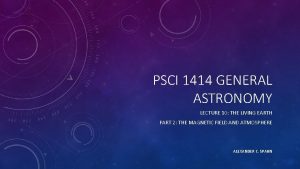PSCI 1414 GENERAL ASTRONOMY LECTURE 6 THE REASON
















- Slides: 16

PSCI 1414 GENERAL ASTRONOMY LECTURE 6: THE REASON FOR SEASONS ALEXANDER C. SPAHN

THE REASON FOR SEASONS You know that we have seasonal changes, such as longer and warmer days in summer and shorter and cooler days in winter. But why do the seasons occur? The reason why we have seasons, and why they are different in different hemispheres, is that the Earth’s axis of rotation is not perpendicular to the plane of Earth’s orbit. Instead, the axis is tilted by about 23. 5° from the perpendicular. The Earth maintains this tilt as it orbits the Sun, with Earth’s north pole always pointing in the same direction throughout the year (toward Polaris).

THE REASON FOR SEASONS

THE REASON FOR SEASONS When the Earth is at the left in the figure, the northern hemisphere is tilted toward the Sun. A point in the northern hemisphere spends more than 12 hours in the sunlight. Thus, the days are long, the nights are short, and it is summer in the northern hemisphere. The Sun is high in the sky and so sunlight strikes the ground at a nearly perpendicular angle that heats the ground efficiently. During this same time in the southern hemisphere, days are short and nights are long. Thus, it is winter in the southern hemisphere.

THE REASON FOR SEASONS Half of a year later, the Earth is at the point shown on the right of the figure. Now, the situation is reversed, with winter in the northern hemisphere (which is now tilted away from the Sun) and summer in the southern hemisphere. The Sun is low in the sky, so sunlight strikes the surface at a grazing angle that causes little heating. During spring and autumn, the two hemispheres receive roughly the same amounts of illumination from the Sun, and daytime and nighttime are of roughly equal length everywhere on Earth.

THE REASON FOR SEASONS Notice that the seasons on Earth are caused only by the axis tilt and not by any change in Earth’s distance from the Sun. Although Earth’s orbital distance varies over the course of each year, the variation is fairly small: Earth is only about 3% farther from the Sun at its farthest point than at its nearest. The difference in the strength of sunlight due to this small change in distance is easily overwhelmed by the effects caused by the axis tilt. If Earth did not have an axis tilt, we would not have seasons.

THE REASON FOR SEASONS Ecliptic plane – The plane of the Earth’s orbit around the Sun. Ecliptic – The circular path that the Sun appears to trace out against the background stars. Because there are 365 days in a year and 360° in a full circle, the Sun appears to move along the ecliptic at a rate of 1° per day, from west to east. Because of the Earth’s tilt, the ecliptic is angled 23. 5° from the equator.

THE REASON FOR SEASONS The ecliptic and the celestial equator intersect at only two points. Each point is called an equinox (from the Latin for “equal night” since day and night are roughly equal in length at these points). Vernal/Spring equinox (March 21) – the moment when the Northern Hemisphere first starts to be tipped toward the Sun. The Sun passes northward across the celestial equator. Autumnal/Fall equinox (September 22) – the moment when the Northern Hemisphere first starts to be tipped away from the Sun. The Sun passes southward across the celestial equator.

THE REASON FOR SEASONS The points where the ecliptic is the farthest north and farthest south of the celestial equator are known as a solstice (from the Latin for “solar standstill” since this is where the Sun changes direction from moving northward to southward or vice versa). Summer solstice (June 21) – the point on the ecliptic farthest north of the celestial equator. This is when the Northern Hemisphere is tipped most directly toward the Sun. Winter solstice (December 21) – the point on the ecliptic farthest south of the celestial equator. This is when the Northern Hemisphere receives the least direct sunlight

THE REASON FOR SEASONS The equinoxes occur on the only two days of the year on which the Sun rises precisely due east and sets precisely due west. The summer solstice is the day on which the Sun rises and sets farthest to the north, and on which the noon Sun reaches its highest point in the Northern Hemisphere sky. The opposite is true on the day of the winter solstice, when the Sun rises and sets farthest to the south and the noon Sun is lower in the Northern Hemisphere sky than on any other day of the year.

THE REASON FOR SEASONS This composite photograph shows images of the Sun taken at the same time of morning and from the same spot at 7 - to 11 -day intervals over the course of a year; the photo looks eastward, so north is to the left and south is to the right. Because this location is in the Northern Hemisphere, the Sun images that are high and to the north represent times near the summer solstice and the images that are low and to the south represent times near the winter solstice. The “figure 8” shape (called an analemma) arises from a combination of Earth’s axis tilt and Earth’s varying speed as it orbits the Sun.

THE REASON FOR SEASONS The Arctic Circle is the southernmost latitude (66. 5° N) in the Northern Hemisphere at which the sun can remain continuously above or below the horizon for 24 hours. The Antarctic Circle is the northernmost latitude (66. 5° S) in the Southern Hemisphere at which the sun can remain continuously above or below the horizon for 24 hours. Between the Tropic of Capricorn (23. 5° S) and the Tropic of Cancer (23. 5° N), the Sun is directly overhead at high noon at least one day a year.

THE REASON FOR SEASONS

CONCEPT CHECK 2. 7 How often each year does an observer standing on Earth’s equator experience no shadow during the noontime Sun? To cast no shadow, the Sun must be directly overhead. As the Sun’s position on the celestial sphere slowly moves back and forth between the northern and southern solstice points over the course of a year, the noontime Sun will be directly overhead for an observer at the equator only twice per year, on the Spring and Autumnal equinoxes.

THE REASON FOR SEASONS We have now discussed both daily and seasonal changes in the sky, but there are other changes that occur over longer periods of time. One of the most important of these slow changes is precession, a gradual wobble that alters the orientation of Earth’s axis in space. Each cycle of Earth’s precession takes about 26, 000 years, gradually changing where the axis points in space. Precession is caused by gravity’s effect on a tilted, rotating object that is not a perfect sphere.

FOR NEXT TIME… • Read Chapter 3 (fairly short chapter) • Homework: Homework 4 (Due Friday) • Exam(s): Include planetary studies and have one exam or separate them and have two?
 Jeremias 1414
Jeremias 1414 Learning astronomy by doing astronomy activity 1 answers
Learning astronomy by doing astronomy activity 1 answers Learning astronomy by doing astronomy activity 7 answers
Learning astronomy by doing astronomy activity 7 answers Learning astronomy by doing astronomy activity 1 answers
Learning astronomy by doing astronomy activity 1 answers Pharmaceutical supply chain initiative psci
Pharmaceutical supply chain initiative psci Pharmaceutical supply chain initiative
Pharmaceutical supply chain initiative Psci audit
Psci audit 01:640:244 lecture notes - lecture 15: plat, idah, farad
01:640:244 lecture notes - lecture 15: plat, idah, farad Wormhost chest worm locations
Wormhost chest worm locations General medicine lecture
General medicine lecture General parasitology lecture notes
General parasitology lecture notes Thơ thất ngôn tứ tuyệt đường luật
Thơ thất ngôn tứ tuyệt đường luật Cái miệng xinh xinh thế chỉ nói điều hay thôi
Cái miệng xinh xinh thế chỉ nói điều hay thôi Các châu lục và đại dương trên thế giới
Các châu lục và đại dương trên thế giới Từ ngữ thể hiện lòng nhân hậu
Từ ngữ thể hiện lòng nhân hậu Diễn thế sinh thái là
Diễn thế sinh thái là Frameset trong html5
Frameset trong html5





























